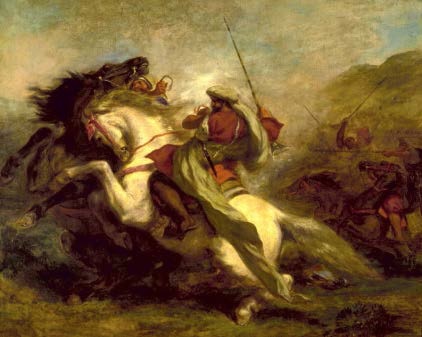
Eugène Delacroix
French, 1798-1863
Collision of Moorish Horsemen, 1843-44
Oil on canvas
32 x 39"
Walters Art Museum, Baltimore, Bequest of Henry Walters
1931 (37.6)
COMMENTS
A virtual replica of the version refused for the Salon of 1834, this picture nevertheless shows an advance towards a more nuanced and atmospheric manner.
The Salon jury of 1834 rejected the picture by nine votes to six, on 19 February. Nevertheless, Alexandre Decamps warmly defended it in his review of the Salon, illustrating it after a drawing by Delacroix from the painting and writing, "we should have […..] an 'Encounter with the Moorish Horsemen,' in which the action has such an energy, the style is of such a loftiness that the public will see themselves in the drawing."
The subject was evidently inspired by an incident in the first "Powder Races" that Delacroix witnessed while travelling on horseback from Tangier to Meknes in Count de Mornay’s party, and which he described thus in a note dated 6 March in one of his North African sketch-books, "Powder Races on the plains before the river. Two men are shocked; one whose horse touched his ass on the ground."
A scientific inspection undertaken by the Walters Art gallery in 1962 revealed new paint concealing damage caused by over-cleaning, particularly in the sky, in the shadows of the falling drapery of the central rider, and in the white of his horse.
- Lee Johnson, The Paintings of Eugène Delacroix, A Critical Catalog, v. III, Oxford, Clarendon Press, 1986, pp. 164-5, 179
SBMA CURATORIAL LABELS
During the journey from Tangier to Meknes, Delacroix witnessed the "course de poudre," a military exercise in which riders launch their horses toward each other at full speed and then abruptly halt after firing their rifles. The horse was a Romantic symbol of the passions, and Delacroix frequently depicted the spirit, energy, and majesty of the animal, particularly in his Orientalist works. Delacroix‘s reconstitution of the event focuses on the wildly violent confrontation of two horses amidst the course, here reinforced by the rebellious energy and movement of the brush, and the tense compacting created by the torsion of the horses‘ diagonal thrust.
- Delacroix and the Matter of Finish, 2013
